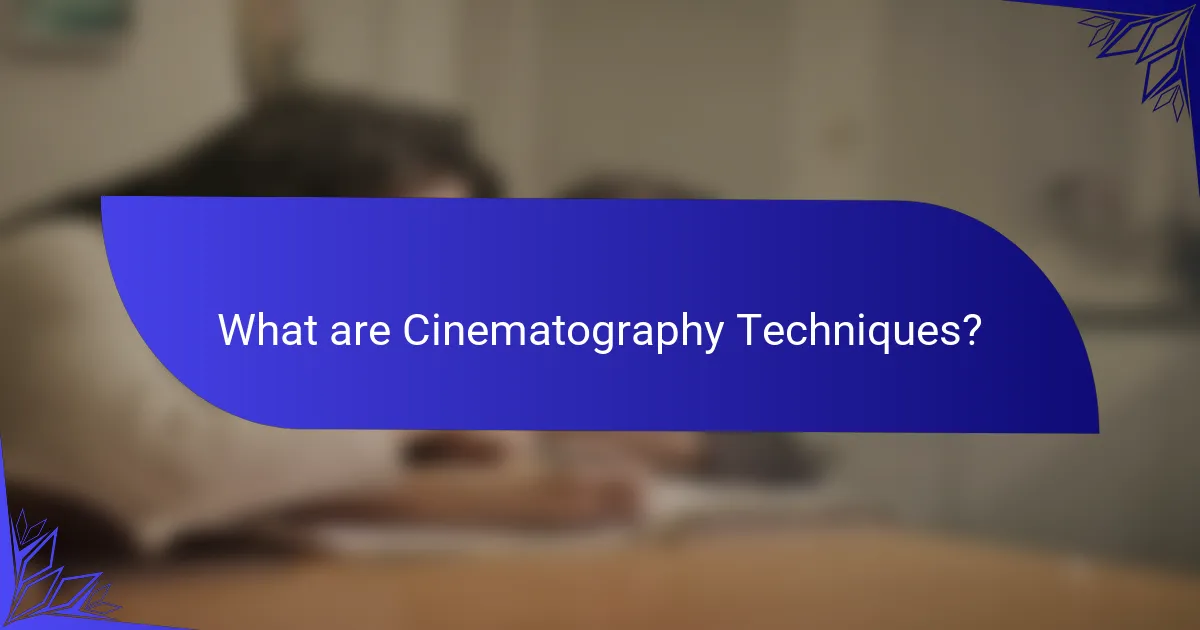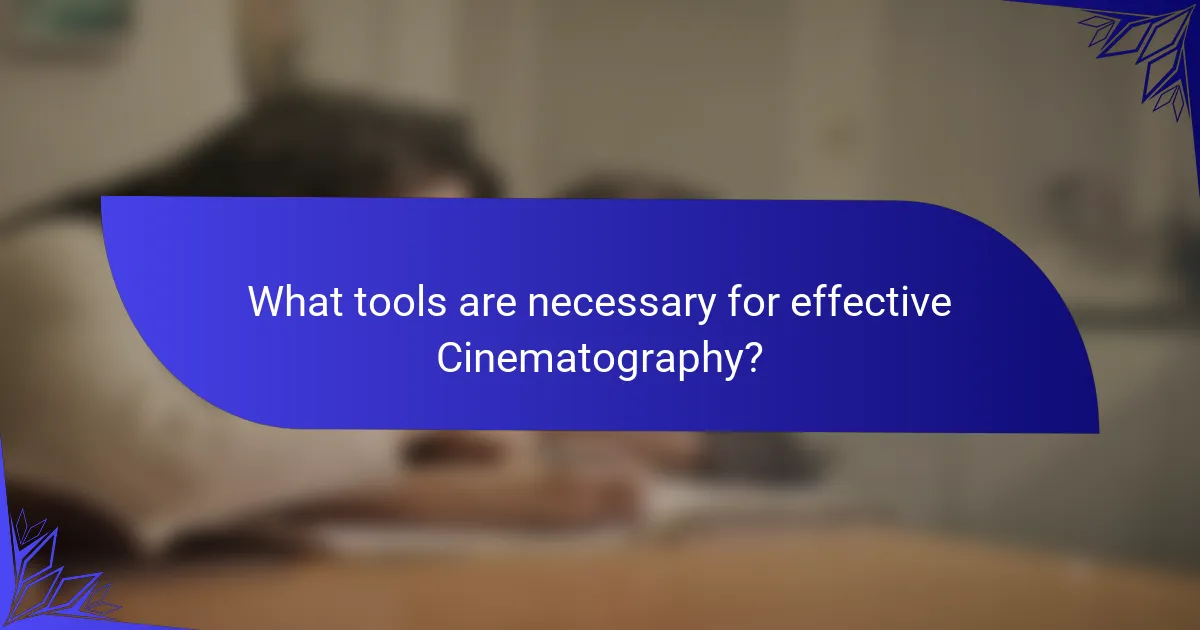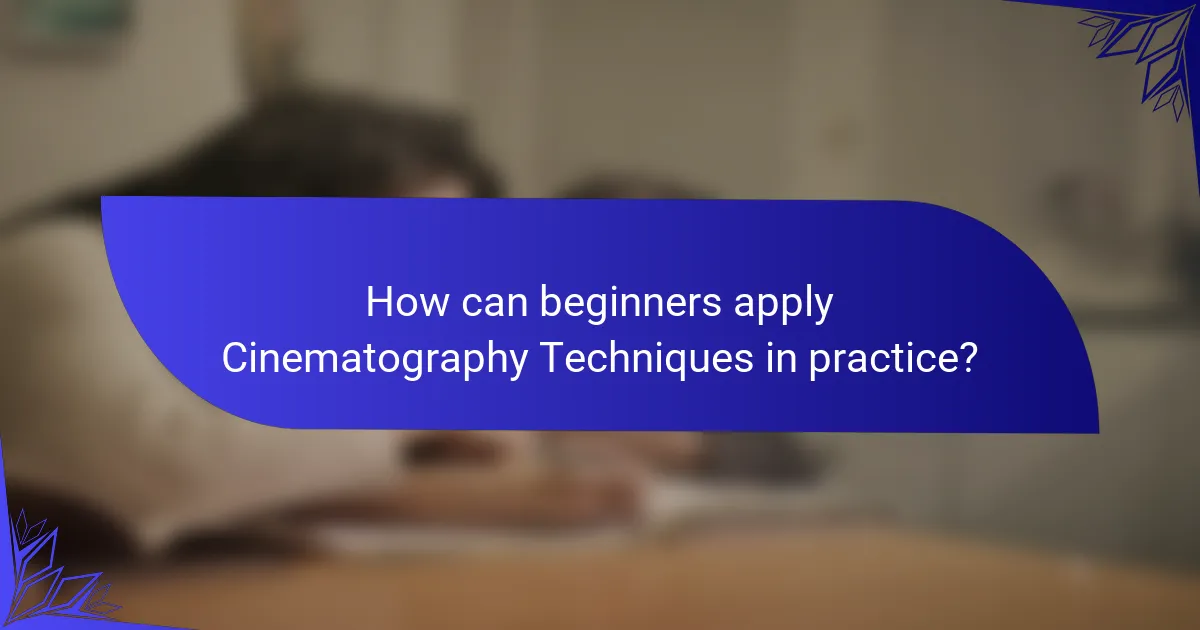Cinematography techniques encompass the methods used to capture visual images in film and video, including camera angles, shot composition, lighting, and movement. These techniques significantly influence storytelling and emotional impact, with specific approaches like low-angle and high-angle shots altering perceptions of power and vulnerability. Essential tools for cinematography include high-quality cameras, lenses, tripods, and lighting equipment, all of which contribute to effective image capture and sound quality. For beginners, mastering basic camera settings, composition, and lighting techniques is crucial for developing their skills, while hands-on practice and critical review of footage facilitate improvement. This article provides a comprehensive guide to cinematography techniques, essential skills, and tools for aspiring filmmakers.

What are Cinematography Techniques?
Cinematography techniques are the methods used to capture visual images in film and video. These techniques include camera angles, shot composition, lighting, and movement. Each technique influences the storytelling and emotional impact of a scene. For example, a low-angle shot can make a subject appear more powerful. Conversely, a high-angle shot can create a sense of vulnerability. Lighting techniques, such as three-point lighting, enhance depth and mood. Camera movement, like panning or tracking, adds dynamism to the visual narrative. Understanding these techniques is essential for effective visual storytelling in cinematography.
How do Cinematography Techniques impact storytelling?
Cinematography techniques significantly impact storytelling by shaping the visual narrative. Techniques such as camera angles, lighting, and shot composition influence audience perception. For instance, a high-angle shot can make a character appear vulnerable. Conversely, a low-angle shot can convey power and dominance. Lighting sets the mood and tone, affecting emotional engagement. For example, harsh lighting can create tension, while soft lighting evokes warmth. Additionally, shot composition guides viewer focus on key elements, enhancing thematic depth. The use of color grading can also alter the emotional landscape of a scene. Overall, these techniques serve as tools to enhance narrative clarity and emotional resonance.
What role does visual composition play in Cinematography?
Visual composition is crucial in cinematography as it determines the arrangement of elements within a frame. Effective visual composition enhances storytelling by guiding the viewer’s eye and emphasizing key subjects. It utilizes principles such as balance, contrast, and symmetry to create visually appealing images. For instance, the rule of thirds helps filmmakers place subjects strategically, leading to a more engaging visual narrative. Additionally, strong visual composition can evoke emotions and set the tone of a scene. Historical examples, such as the work of cinematographer Roger Deakins, illustrate how thoughtful composition elevates the cinematic experience. Overall, visual composition shapes how audiences perceive and connect with the story being told.
How does lighting influence the mood in Cinematography?
Lighting significantly influences the mood in cinematography. It sets the emotional tone of a scene. Different lighting techniques evoke various feelings. For instance, high-key lighting creates a bright, cheerful atmosphere. In contrast, low-key lighting generates tension or suspense. Color temperature also plays a role; warm tones can evoke comfort, while cool tones may suggest sadness. Shadows can enhance drama and depth. Studies show that lighting affects viewer perception and emotional response. Effective lighting can transform a narrative by guiding audience emotions throughout the film.
Why are Cinematography Techniques essential for beginners?
Cinematography techniques are essential for beginners because they provide foundational skills for visual storytelling. Mastering these techniques enhances a beginner’s ability to convey emotions and narratives effectively. Techniques such as framing, lighting, and camera movement significantly impact the viewer’s experience. Understanding these elements allows beginners to create visually engaging content. Research indicates that effective cinematography can increase audience engagement by up to 70%. This statistic highlights the importance of learning these techniques early in a filmmaker’s journey. Therefore, beginners who grasp cinematography techniques are better equipped to produce compelling and professional-quality films.
What foundational skills should beginners focus on?
Beginners in cinematography should focus on understanding composition, lighting, and camera operation. Composition involves framing shots to create visually appealing images. Mastering the rule of thirds can enhance visual storytelling. Lighting is crucial for setting the mood and tone of a scene. Beginners should learn to manipulate natural and artificial light sources. Camera operation includes familiarity with settings such as aperture, shutter speed, and ISO. Understanding these settings affects exposure and depth of field. Practicing these foundational skills leads to improved cinematography. According to the American Society of Cinematographers, mastering these basics is essential for aspiring filmmakers.
How can beginners develop their eye for framing and composition?
Beginners can develop their eye for framing and composition by practicing observation and analysis. They should study photographs and films to understand visual balance. Using the rule of thirds can help in arranging subjects effectively. Beginners should also experiment with different angles and perspectives. Taking time to visualize shots before capturing them is crucial. Regularly reviewing their own work can provide insights into improvement. Engaging in critiques with peers can enhance their understanding. Additionally, using tools like grids can aid in achieving better composition.

What tools are necessary for effective Cinematography?
Cinematography requires several essential tools for effective execution. A high-quality camera is fundamental for capturing images. Lenses are crucial as they affect the field of view and depth of field. Tripods provide stability for smooth shots. Lighting equipment enhances visibility and mood in scenes. Audio recording devices are necessary for capturing clear sound. Gimbals or stabilizers help achieve steady movement. Editing software is essential for post-production work. Each tool plays a vital role in the overall cinematographic process.
Which cameras are best suited for beginner cinematographers?
DSLR cameras and mirrorless cameras are best suited for beginner cinematographers. These cameras offer manual controls, interchangeable lenses, and high-quality video capabilities. Popular models include the Canon EOS Rebel series and the Sony Alpha a6000 series. They provide user-friendly interfaces and excellent autofocus systems. Additionally, they support full HD and 4K video recording. This versatility allows beginners to learn various cinematography techniques effectively. Reviews consistently highlight their affordability and performance for entry-level filmmakers.
What features should beginners look for in a camera?
Beginners should look for user-friendly features in a camera. Key features include automatic modes for ease of use. A built-in image stabilization system helps reduce blur. A good autofocus system ensures sharp images. A lightweight design enhances portability for beginners. Interchangeable lenses provide versatility for different shooting situations. A decent battery life is crucial for extended shooting sessions. Finally, a clear, intuitive menu system simplifies navigation for new users.
How do lenses affect the quality of cinematography?
Lenses significantly influence the quality of cinematography by determining image sharpness, depth of field, and color rendition. The focal length of a lens affects the composition and perspective of a shot. Wide-angle lenses capture more of the scene, while telephoto lenses compress space and isolate subjects. Additionally, the aperture size impacts exposure and bokeh, creating aesthetic backgrounds. Different lens coatings can enhance contrast and reduce lens flare, impacting overall image quality. High-quality lenses provide better optical performance, leading to clearer and more vibrant images. Studies show that professional cinematographers often select specific lenses to achieve desired visual styles, demonstrating their crucial role in film production.
What accessories enhance Cinematography techniques?
Camera stabilizers enhance cinematography techniques by providing smooth motion and reducing shake. They allow filmmakers to capture dynamic shots while maintaining stability. Common stabilizers include gimbals and steadicams. Gimbals use motors to balance the camera, ensuring fluid movement. Steadicams rely on a counterweight system for stabilization.
Lighting equipment enhances cinematography by controlling exposure and creating mood. Softboxes and LED panels are popular choices. They diffuse light for softer shadows and even illumination. Proper lighting can dramatically affect the visual storytelling of a scene.
Lenses also play a crucial role in cinematography. Different lenses offer various focal lengths and depths of field. Wide-angle lenses capture expansive scenes, while telephoto lenses focus on distant subjects. The choice of lens can influence the viewer’s perception and emotional response.
Filters enhance cinematography by modifying light entering the lens. ND filters reduce light intensity, allowing for wider apertures in bright conditions. Polarizing filters enhance colors and reduce reflections. These accessories contribute to the overall aesthetic and technical quality of the film.
How do tripods and stabilizers improve shot quality?
Tripods and stabilizers enhance shot quality by providing stability and reducing camera shake. A tripod allows for steady framing, which is crucial for sharp images. It prevents unwanted movement during long exposures or time-lapse shots. Stabilizers, such as gimbals, counteract motion, ensuring smooth footage during dynamic scenes. This results in professional-looking videos that maintain viewer engagement. Research shows that stabilized footage is perceived as more visually appealing. Studies indicate that shaky footage can lead to viewer discomfort and disengagement. Therefore, using tripods and stabilizers is essential for achieving high-quality cinematography.
What role do microphones play in capturing sound for Cinematography?
Microphones are essential tools in capturing sound for cinematography. They convert sound waves into electrical signals. This process allows filmmakers to record dialogue, ambient sounds, and sound effects. High-quality microphones enhance the audio clarity in films. Different types of microphones serve various purposes, such as shotgun microphones for directional sound capture. Lavalier microphones are often used for capturing dialogue discreetly. Proper microphone placement is crucial for optimal sound quality. The choice of microphone impacts the overall production value of a film.

How can beginners apply Cinematography Techniques in practice?
Beginners can apply cinematography techniques in practice by starting with basic camera settings. They should learn to adjust exposure, aperture, and shutter speed. Understanding the relationship between these settings helps achieve desired effects. Practicing composition is crucial; they can frame shots using the rule of thirds. Experimenting with different angles enhances storytelling. Beginners should also familiarize themselves with lighting techniques. Natural light can be a great starting point. Using reflectors can help manipulate light effectively. Finally, reviewing footage critically allows beginners to identify areas for improvement. Engaging in hands-on projects reinforces these skills.
What are some essential tips for shooting your first project?
Plan your shots in advance. Create a storyboard to visualize your scenes. Choose the right equipment for your project. Ensure your camera settings are appropriate for lighting conditions. Use a tripod to stabilize your shots. Pay attention to framing and composition. Capture multiple takes to ensure quality. Review your footage regularly during shooting. These tips help beginners achieve better results in cinematography projects.
How can storyboarding improve your cinematography planning?
Storyboarding enhances cinematography planning by providing a visual blueprint for the film. It allows filmmakers to outline scenes, shot compositions, and camera movements. This process helps in visualizing the narrative structure and pacing. By detailing each shot, storyboarding minimizes ambiguity during filming. It also facilitates communication among the crew, ensuring everyone understands the vision. Research indicates that films with storyboards experience fewer production delays. A study by the University of Southern California found that storyboarding can reduce shooting time by up to 30%. This efficiency ultimately leads to a more organized and cohesive final product.
What common mistakes should beginners avoid in Cinematography?
Beginners in cinematography should avoid several common mistakes. One mistake is not understanding lighting. Proper lighting enhances the mood and clarity of a shot. Another mistake is neglecting composition. Good composition guides the viewer’s eye and creates visual interest. Beginners often overlook camera settings as well. Incorrect settings can lead to poor exposure and focus issues. Additionally, failing to plan shots can result in disorganized footage. Storyboarding or shot lists help maintain focus during filming. Beginners may also misuse depth of field. Understanding how to manipulate it can create more engaging visuals. Lastly, not experimenting with angles can limit creativity. Trying different perspectives can significantly improve storytelling.
What resources are available for learning Cinematography Techniques?
Online courses, books, and video tutorials are available for learning cinematography techniques. Websites like MasterClass and Udemy offer structured courses taught by industry professionals. Books such as “Cinematography: Theory and Practice” provide in-depth knowledge and technical insights. YouTube hosts numerous channels dedicated to cinematography, featuring practical demonstrations and tips. Film schools also offer formal education in cinematography, combining theory with hands-on experience. Additionally, forums and communities like Reddit’s r/cinematography allow for peer support and sharing of resources. These options cater to various learning preferences and budgets, making cinematography accessible to all.
How can online courses and tutorials benefit aspiring cinematographers?
Online courses and tutorials can significantly benefit aspiring cinematographers by providing accessible education and practical skills. They offer structured learning paths that cover essential cinematography concepts. Topics include camera operation, lighting techniques, and composition strategies. Many courses include video demonstrations and real-world examples. This hands-on approach enhances understanding and retention of information. Additionally, online platforms often allow for flexible learning schedules. Aspiring cinematographers can learn at their own pace, fitting education into their busy lives. Many courses also provide opportunities for peer feedback and community interaction. This networking can lead to collaboration and mentorship opportunities within the industry. Overall, online education equips aspiring cinematographers with the necessary skills to succeed in a competitive field.
What books are recommended for understanding Cinematography fundamentals?
“Understanding Cinematography fundamentals can be enhanced by several key books. ‘Cinematography: Theory and Practice’ by Blain Brown provides comprehensive insights into the technical and artistic aspects of cinematography. ‘The Five C’s of Cinematography’ by Joseph V. Mascelli focuses on the essential principles of camera work. ‘Filmcraft: Cinematography’ by Bruce M. T. Johnson offers a collection of industry insights and interviews with professionals. ‘Mastering Cinematography’ by David Stump covers advanced techniques and visual storytelling. Each of these books serves as a valuable resource for grasping the core concepts of cinematography.”
What best practices should beginners follow in Cinematography?
Beginners in cinematography should focus on mastering the fundamentals. Understanding lighting is crucial; it shapes the mood and tone of a scene. Composition techniques, such as the rule of thirds, enhance visual storytelling. Familiarity with camera settings like aperture, shutter speed, and ISO is essential for exposure control. Practicing different shot types, including wide shots and close-ups, helps convey emotions effectively. Utilizing a tripod stabilizes footage, preventing shaky images. Learning to read and interpret a script aids in visual planning. Finally, reviewing and analyzing films can provide valuable insights into professional techniques.
Cinematography techniques encompass the methods used to capture visual images in film and video, including camera angles, shot composition, lighting, and movement. This article provides an overview of essential skills and tools for beginner cinematographers, emphasizing the impact of these techniques on storytelling and emotional engagement. Key topics include foundational skills such as composition and lighting, the importance of equipment like cameras and lenses, and practical tips for applying cinematography techniques effectively. Additionally, resources for learning and common mistakes to avoid are discussed, offering a comprehensive guide for aspiring filmmakers.